
Return to - the Ancient Parish of Standish Return to mylesstandish.info
4. People and events in Adlington 1305 to 1881.

The Manor of Adlington.
within the -
Ancient Parish of Standish Lancashire England.
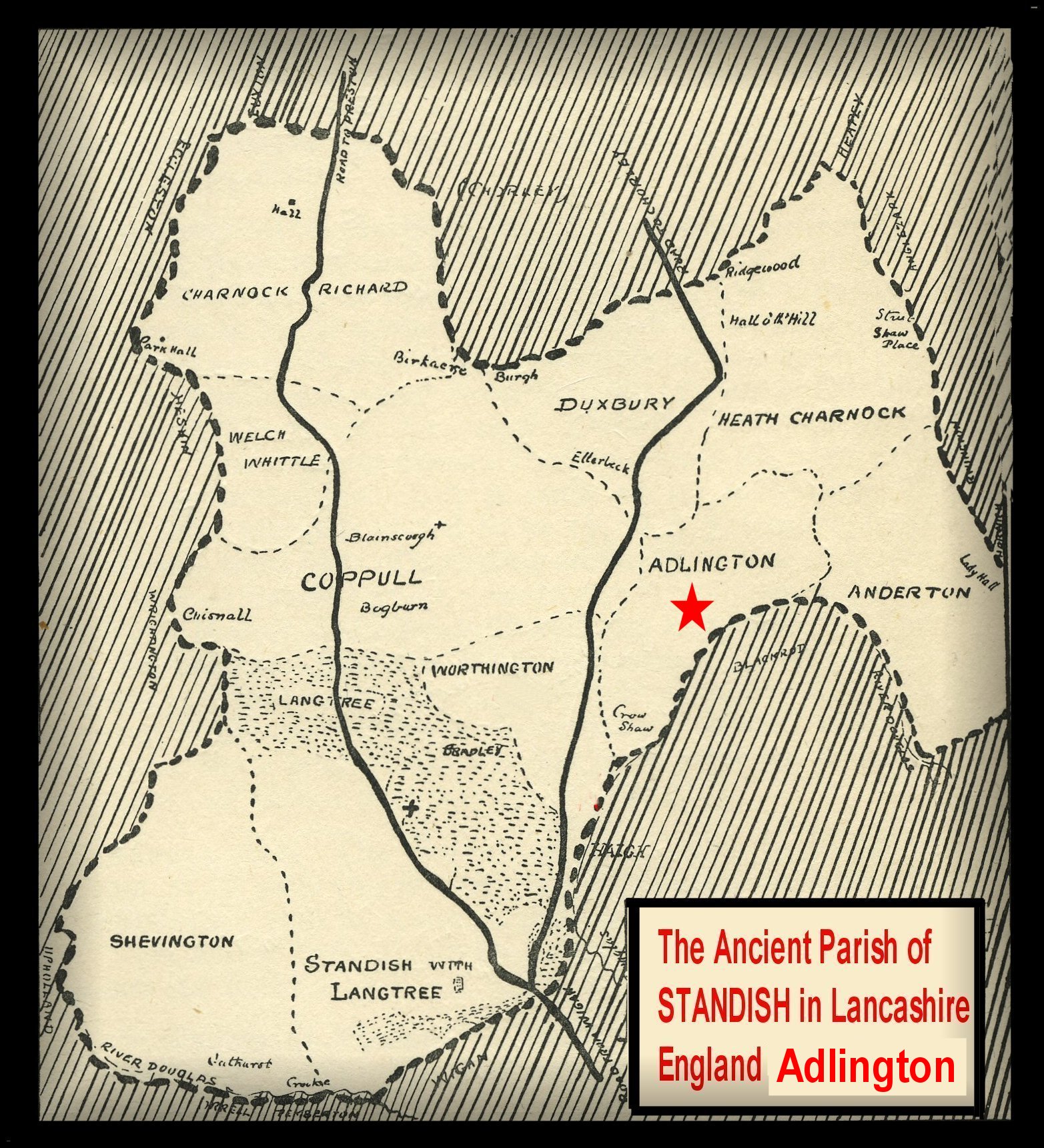
Adelventon, 1202; Adlinton, 1292; Adlincton, 1295; Addelyngton, 1346.
This township is bounded on the south-east by the Douglas, and is separated by Buckow Brook from Worthington on the west and by the Ellerbeck from Duxbury on the north.
Sixty-two hearths in all were enumerated for the hearth tax of 1666, the largest houses having six each.
Subs. R. Lancs. bdle. 250, no. 9. The houses of Peter Adlington and Ralph Bayley were those having six hearths; Lawrence Worthington's had five.
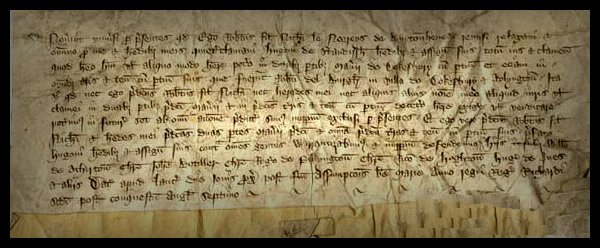
ADLINGTON - part of the five plough-lands belonging to the barony of Penwortham granted by Warine Bussell to Randle son of Roger de Marsey, [Lancs. Inq. and Extents (Rec. Soc. Lancs, and Ches.), i, 29.]
The Earl of Lincoln, as lord of Penwortham, had in 1311 an ancient yearly rent of 3s. from Duxbury and Adlington; [De Lacy Inq. (Chet. Soc.), 22]
It was held in later times by the Ferrers family and the lords of Leylandshire. In this way it became joined with Heath Charnock in the feodaries. In 1378 it was stated that Sir Nicholas de Harrington and his parceners held the third part of a knight's fee in these townships, [Harl. MS. 2085, fol. 123.]
In 1445–6 Lord Ferrers of Groby and Thomas Harrington held the same third part. [Duchy of Lanc. Knights' Fees, bdle. 2, no. 20.]
There seems to have been a partition between them, for in the later inquisitions certain lands are stated to be held of Lord Mounteagle, the successor of the Harringtons, while others were held of the lords of Leylandshire.
The immediate lordship was held by a local family, but in 1202
Walter de Adlington granted 6 oxgangs of his land to Siward de Duxbury, [Final
Conc. (Rec. Soc. Lancs. and Ches.), i, 18. As an assize of mort d'ancestor
had been summoned between them the division was perhaps due to inheritance
through co-heiresses. Siward de Duxbury, however, was to hold of Walter, paying
a rent of 3s. 6d. at Martinmas.]
It was found that in 1288 Adlington was held of William de Ferrers
in moieties, Hugh de Adlington holding one by a rent of 2s. 9d.,
suit to the wapentake court, and half a pound of cammin, value 1½d.,
while Adam de Duxbury held the other by a rent of 2s. 9d. [Lancs.
Inq. and Extents, i, 269, 270. ]
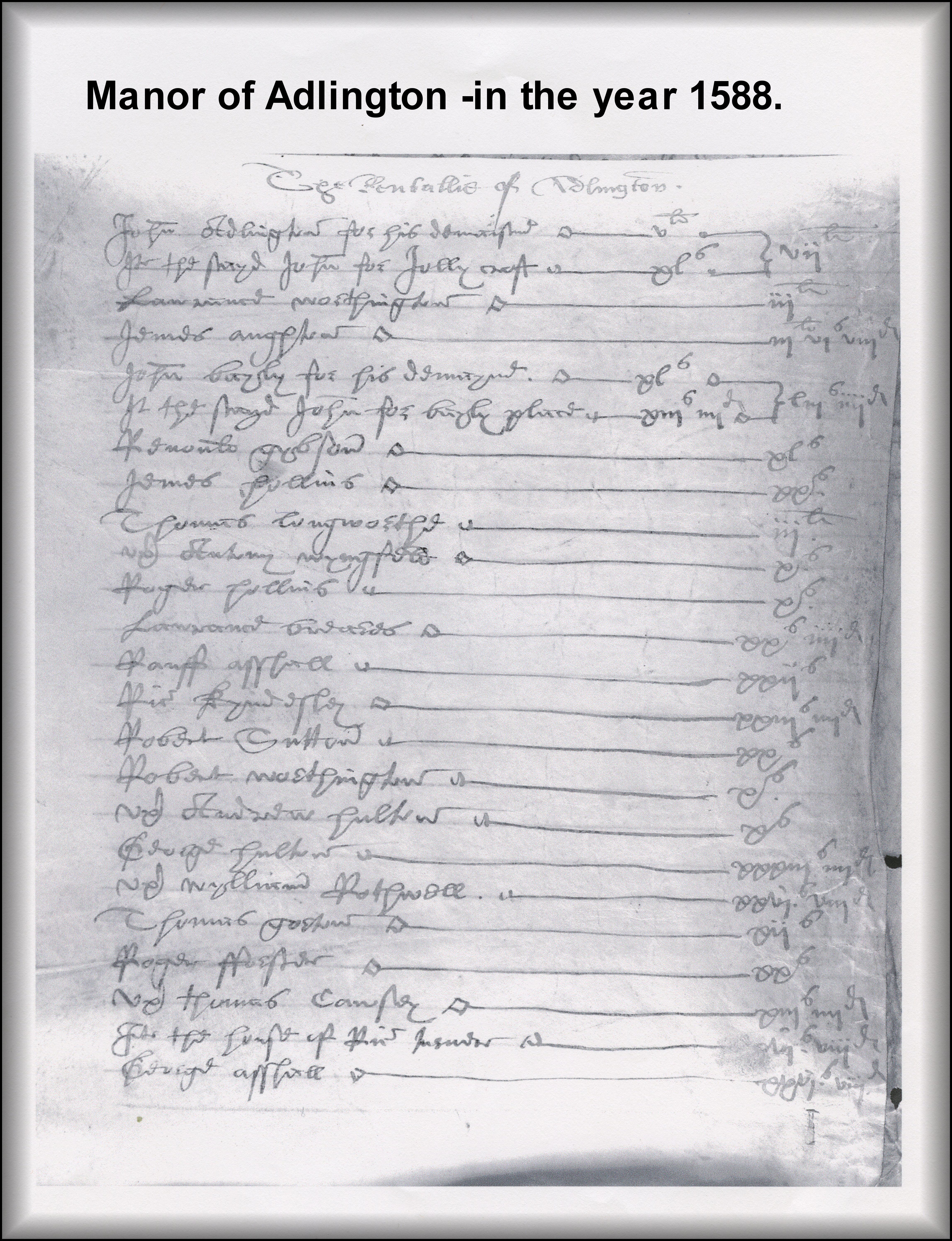

![]()
Adlington Family.

Adlington. Sable a cheveron between three antelopes' heads argent attired or.
The Adlington family.
Of the Adlington family there are but scanty records till the 16th
century. From the change of rent payable according to the 16th-century
inquisitions it appears that the Adlington family then had more than the moiety
held in 1288, but land in Duxbury was included in the later tenement.
Some notes of the family charters are preserved in Kuerden MSS. iii,
A 2, and iv, A 2. See also an account of the family in Pal. Note-book,
v, 4–7.
In 1246 Roger, John and Randle de Adlington called upon William de
Ferrers (as successor of Marsey) to acquit them of the services demanded by the
guardians of the Earl of Lincoln's lands (in right of the fee of Penwortham);
Assize R. 404, m. 14 d. Richard de Adlington was a juror in 1254; Lancs.
Inq. and Extents, i, 193.
Alice widow of Richard de Adlington resigned to Hugh her eldest son part of her land in Adlington, to be held of William de Ferrers; Kuerden MSS. iii, A 2, no. 23. She also granted to William son of William de Worthington and his wife Mabel her daughter lands in Edcroft, Chollaycroft and Godithcroft, with the service of Robert le Noreys; ibid. no. 24.
Hugh de Adlington, was tenant of a moiety in 1288. In
1292 he was non-suited in a claim against Robert le Noreys respecting a
tenement in Adlington, while William de Worthington and Mabel his wife were
non-suited in a claim against Hugh de Adlington; Assize R. 408, m. 46, 57. In
the same year Hugh conceded a moiety of the waste in Adlington to William de
Worthington and Mabel; Kuerden, loc. cit. no. 25.
There was another Hugh then living, son of John de Adlington. He granted to
William his son land between Blackrod and the lands of Hugh de Adlington with
the homage, &c., of Hugh the brother of William and of William de
Blackburnshire and Isabel his wife. This land was held of Henry de Duxbury;
ibid. no. 22. Ellen widow of Hugh de Adlington in 1320–1 gave half the manor of
Adlington to William her eldest son; ibid. no. 4.
Robert le Noreys the younger in 1319 called Thomas son of Hugh de Adlington to
warrant him; De Banco R. 230, m. 70 d. Thomas de Adlington made an exchange of
lands in 1345; Kuerden, loc. cit. no. 6. Thomas and John de Adlington
contributed to the subsidy in 1332; Exch. Lay Subs. (Rec. Soc. Lancs.
and Ches.), 53. The latter is probably the John son of Hugh de Adlington to
whom his father's trustee in 1307 (?) gave certain lands in Adlington; Kuerden,
loc. cit. no. 2. At the same time John de Adlington gave to Gilbert de
Standish, rector of Standish, the manor of Adlington and lands in Duxbury and
Chorley; ibid. no 1. The date (1 Edw. II) is a difficulty, because Gilbert did
not become rector till 1357. The first witness was Sir William Banaster, kt.
Robert le Noreys, already mentioned, in 1322 made a settlement of his estate in
Blackrod and Adlington; Final Conc. ii, 48. His son Hugh in 1359 granted
to Richard son of Hugh de Duxbury lands in Adlington received from Thomas son
of Thomas de Adlington; Kuerden MSS. iii, W 31, no. 1174.
In 1374 Sir Nicholas de Harrington complained that Robert de Rishton had
abducted Thomas son and heir of Hugh de Adlington, and he claimed wardship; De
Banco R. 455, m. 168 d., 424.
Hugh de Adlington, Cecily his wife, Nicholas de Worthington and Joan his wife had in 1443 a plea respecting land with John son of Robert del Street; Pal. of Lanc. Plea R. 5, m. 8.
Robert Adlington was in 1450 the husband of Elizabeth, one of the daughters and
heirs of William Thornton of Thornton in the Fylde, and her share of the manor
descended in the Adlington family till 1601; Final Conc. iii, 117.
Hugh Adlington the elder in 1469 granted to Robert his son and heir the manor
of Adlington with appurtenances and lands there and in Duxbury, Coppull,
Worthington and Chorley; Kuerden MSS. iii, A 2, no. 7. Robert at once made a
feoffment of the manor, and it was regranted to him in 1476 with successive
remainders to his sons Hugh and Christopher; ibid. no. 8, 9. In the following
year the Abbot of Abingdon gave leave to Robert Adlington, Elizabeth his wife
and others to choose a confessor with plenary indulgence; ibid. no. 16. This
Elizabeth was a daughter of Henry Rishton; Dunkenhalgh D. (1475).
A marriage between Robert son of Hugh son of Robert Adlington and Lora daughter
of Gilbert Langtree was agreed upon in 1489–90; Kuerden, loc. cit. no. 21. In
1495 Robert Adlington the elder demised to Hugh his son and heir the manor of
Adlington; ibid. no. 10. Hugh Adlington in 1512 granted to Robert, his son and
heir, and George Carleton the manor of Adlington, &c.; ibid. no. 12. This
may have been a settlement on the occasion of Robert's marriage.
Hugh Adlington died 28 September 1525 holding messuages, &c., in Adlington, Duxbury, Chorley, Coppull, Worthington and Thornton. The estate in Adlington and Duxbury, which is not called a manor, was held of Lord Mounteagle by fealty and a rent of 3s. 9d. Hugh's son Robert having died before his father, the heir was Hugh son of Robert, then ten years old. [Duchy of Lanc. Inq. p.m. vi, no. 73. There are recited the provisions made by Hugh the elder for his grandson's wife Margaret daughter of Roger Asshaw. Besides Robert there was a younger son Gilbert.]
Hugh Adlington the herald
'spake not withal' at the visitation of 1533 [Visit. of 1533 (Chet.
Soc.), 192.] he died in 1556 holding the same estate and leaving as heir his
son John, aged eighteen years. Duchy of Lanc. Inq. p.m. x, no. 34.
John Adlington made various settlements of his manor of Adlington, with its
dovecote, water-mill, &c., and lands in the township in 1560, 1572 and
1591; Pal. of Lanc. Feet of F. bdle. 22, m. 42; 32, m. 76; 41, m. 60; 53, m.
237. In the last his wife Margaret and his son and heir Hugh were joined with
him. Out of one of these settlements a dispute arose in 1588, Roger Adlington
brother of John claiming as next in succession; Duchy of Lanc. Plead. Eliz. cxliv,
A 22; cxcvi, A 1; cxliv, A 11.
Hugh Adlington (1556) had had an elder son Robert, whose marriage with
Katherine daughter of Ralph Orrell of Turton was agreed on in 1549. Hugh died,
and his widow married Ralph Bradshaw, and they in 1564 claimed various lands
against John the brother and heir of Hugh; ibid. Eliz. lviii, B 25.
Pedigrees were recorded in 1567, 1613 and 1664, [Printed by the
Chetham Society:Visit. 1567, p. 70; 1613, p. 119; 1664. p. 1.] so that
the descent of the estate is clear for this period. Hugh Adlington died at
Adlington in 1640 holding the 'manor' of Lord Morley and Mounteagle by the old
rent of 3s. 9d., but no other lands are named in the inquisition.
His son and heir Hugh was forty years of age. [Duchy of Lanc. Inq. p.m. xxix,
no. 2.
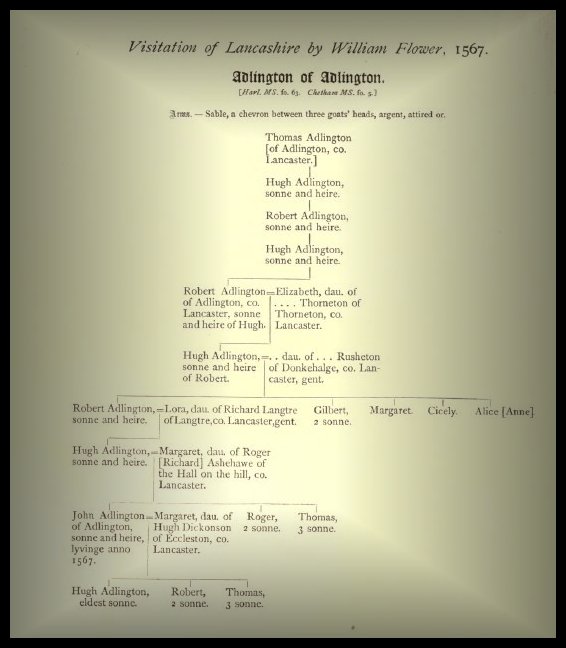
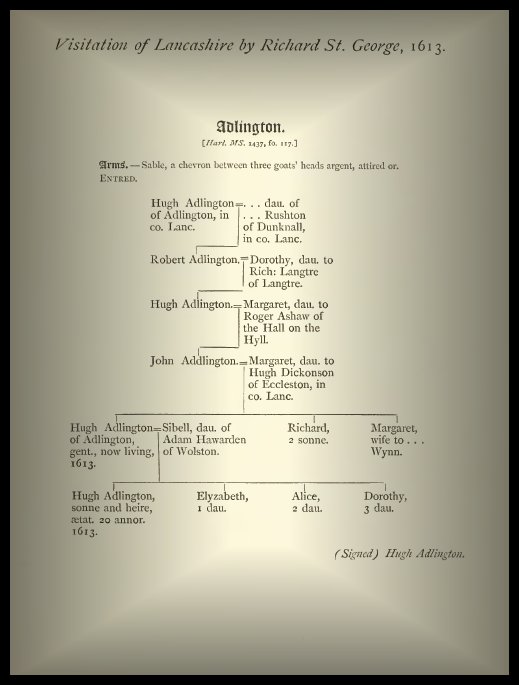
In 1625 Hugh son and heir of Hugh Adlington sold land called
Jollycrofts to Peter Anderton of Anderton; Pal. Notebook, v, 6. William
Anderton (son of Peter) sold the same in 1653 to George Shaw of Anglezarke;
Piccope MSS. (Chet. Lib.), iii, 400.]
Hugh's eldest son John died before him—being killed, it was stated, while assisting the king's forces at the siege of Chester in 1644 [Royalist Comp. Papers (Rec. Soc. Lancs. and Ches.), i, 11–17. The father's estate was seized by the Parliament for the son's 'delinquency,' and after being restored to the father was again 'secured,' he being called upon to show his title.]
Hugh was succeeded by a younger son, Peter; but, he having no surviving issue, the manor descended to John's daughter Eleanor, who married Samuel Robinson of Chester, a settlement of the estate being made in 1664. [See the visitation pedigree; Pal. of Lanc. Feet of F. bdle. 173, m. 74; Cal. Exch. of Pleas, A 33.]
Thomas Aughton in 1468 complained of assault at Adlington by Hugh,
Robert, Christopher, James and Robert son of Robert Adlington and others; Pal.
of Lanc. Writs Proton. file 8, Edw. IV. Thomas Aughton was a defendant in 1530;
Pal. of Lanc. Plea R. 148, m. 13 d.
James Aughton alias Hollins died in 1597 holding a messuage, in
Adlington of John Adlington as of his manor of Adlington by the moiety of a
knight's fee and a rent of 3d. Hugh his son and heir was seventeen years
of age; Duchy of Lanc. Inq. p.m. xvii, no. 78.
According to a pedigree recorded in 1567 (Visit. p. 68), John Aughton of Adlington was descended from a Thomas Aughton who had married the heir of Charnock of Adlington.
![]()
Clayton Family.

Claynton of Adlington, baronet. Argent a cross engrailed sable between four toureaux.
It was before 1700 purchased by a merchant, Thomas Clayton, who also acquired Worthington, and died in 1722, aged ninety-one. The estate descended to his grandson Richard Clayton, chief justice of the Common Pleas in Ireland. After his death in 1770 it went to his nephew, Sir Richard, created a baronet in 1774. He died while consul at Nantes in 1828, and was ultimately succeeded by his daughter Henrietta wife of General Robert Browne, who assumed the surname of Clayton.
[See Raines in Notitia Cestr. iii, 393, and Baines, Lancs.
(ed. 1836), iii, 515; Sir Robert, a younger brother of Sir Richard, had a life
interest in the manor. Pedigrees of the family will be found in the older
Baronetages and in Burke'sLanded Gentry, but they are erroneous, and
have been superseded by that of Mr. R. Stewart-Brown in the Genealogist.
Thomas Clayton, the younger brother of Robert Clayton of Fulwood, was described
as 'citizen of London' in the pedigree recorded in 1664 and as 'merchant of
Liverpool' in the Preston Guild Roll of 1682. Thomas has a monument in Standish
Church. His son Richard, who died in 1728, had a numerous family, Sir Richard
the judge, who also has a monument in Standish Church, being the third son, and
John, the father of the first baronet, being the fifth.
Their only son, (Henrietta Clayton and General Robert Browne) Richard Clayton Browne - Clayton, died at Bournemouth in November 1886, and, his only son having fallen in the attack on the Redan at Sebastopol, Adlington Hall went to Mr. James Robert Browne Clayton Dawbeny.
Adlington Hall is a modern classic mansion of brick and stone, standing on high ground, erected about 1770 by Sir Richard Clayton, bart., on the site of an ancient timber and plaster house. The front, which faces south, has a projecting middle part with rusticated base and pediment, and is two stories in height with an attic.
Sir Richard Clayton and Thomas Gillibrand were the chief landowners in 1783, the former paying about half the land tax.
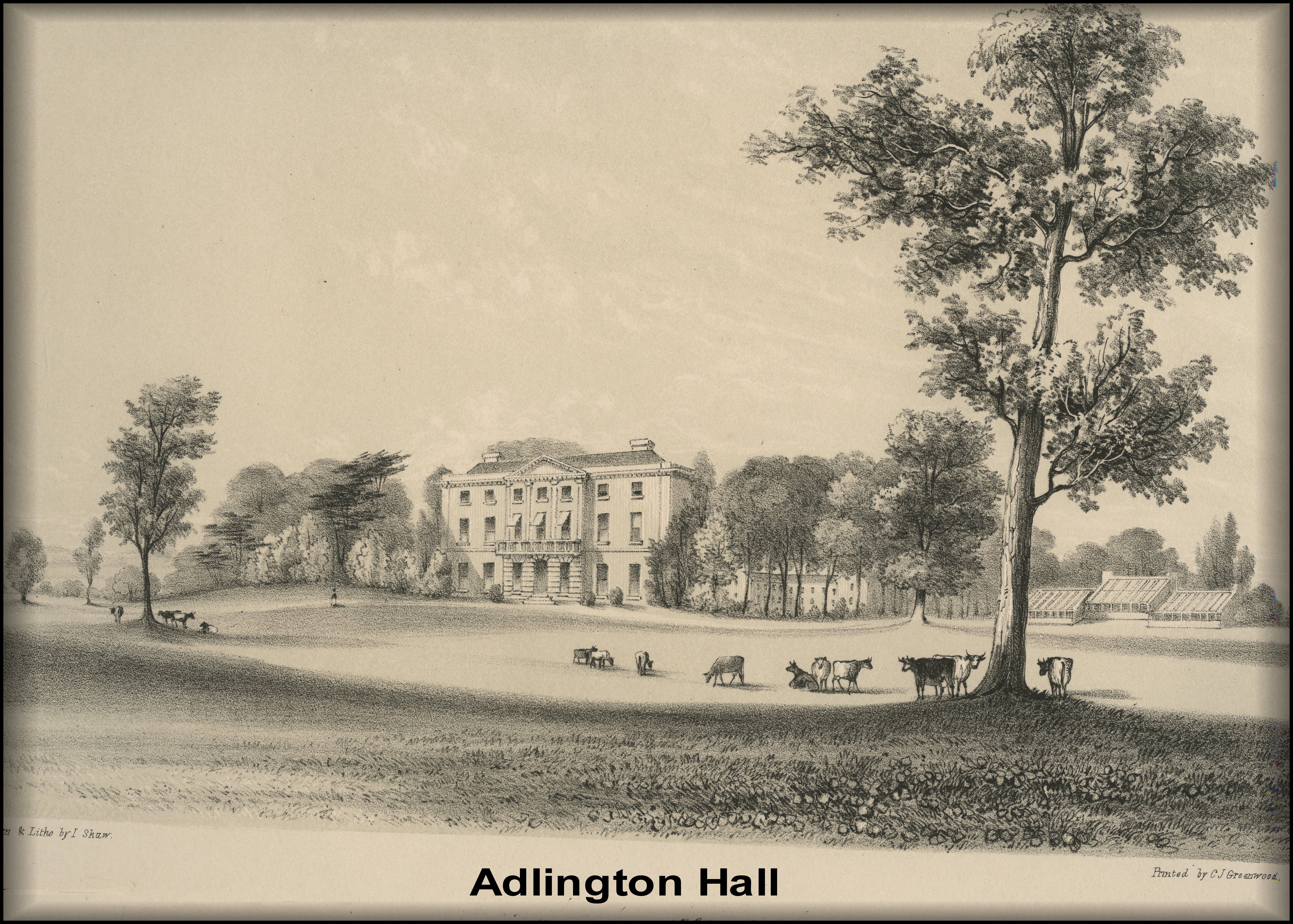

Letter written by Sir Richard Clayton at Adlington Hall 29th March 1813.

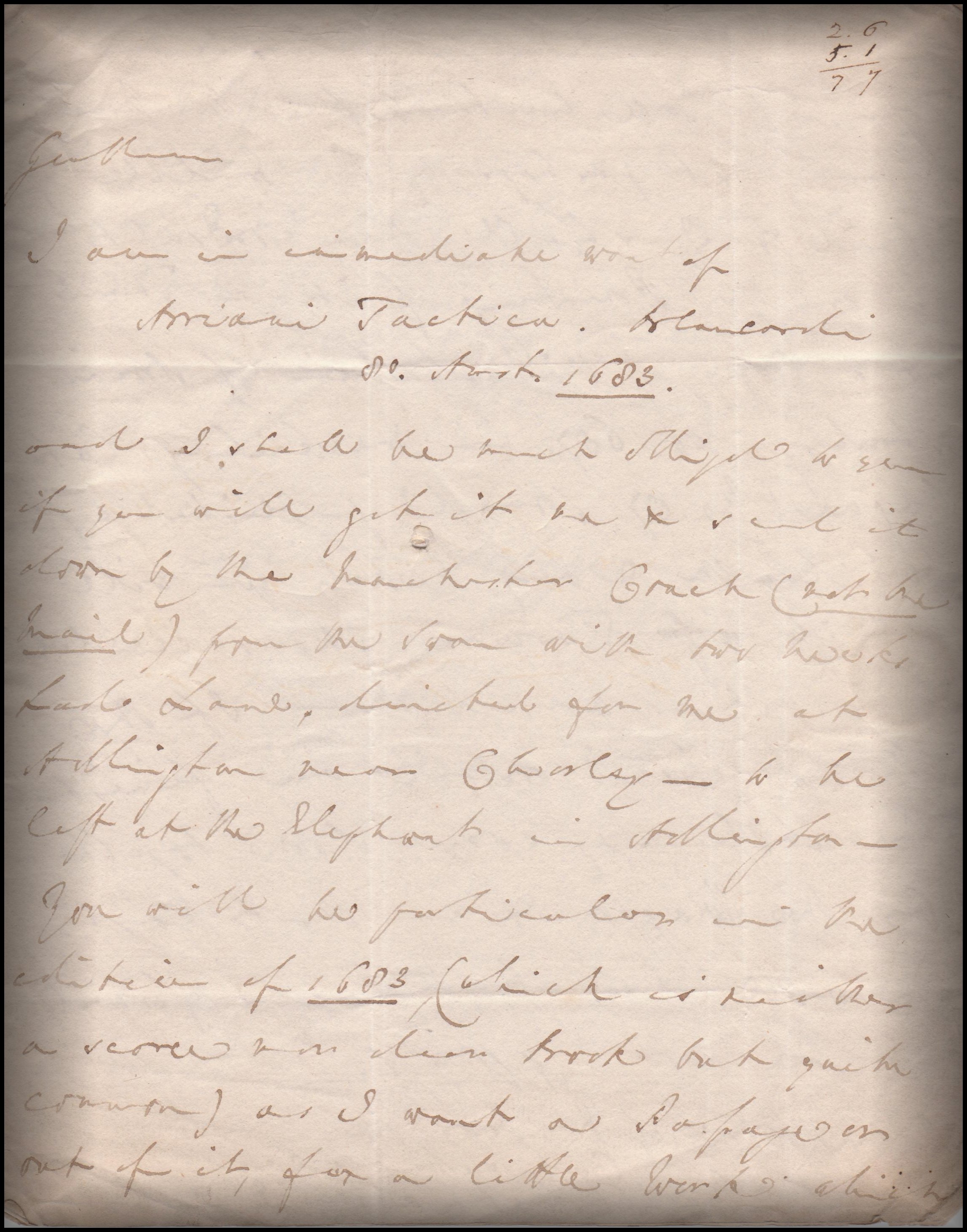
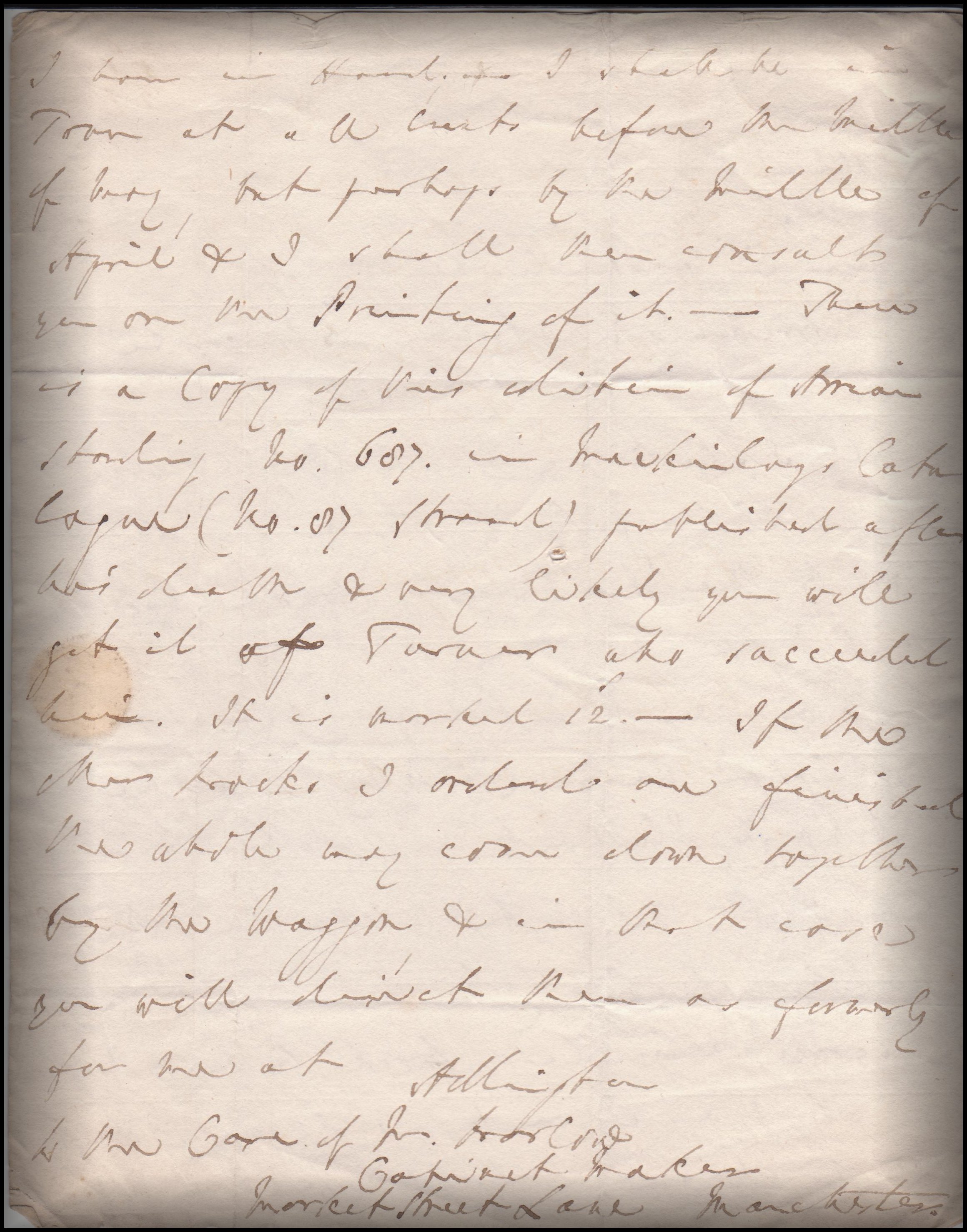
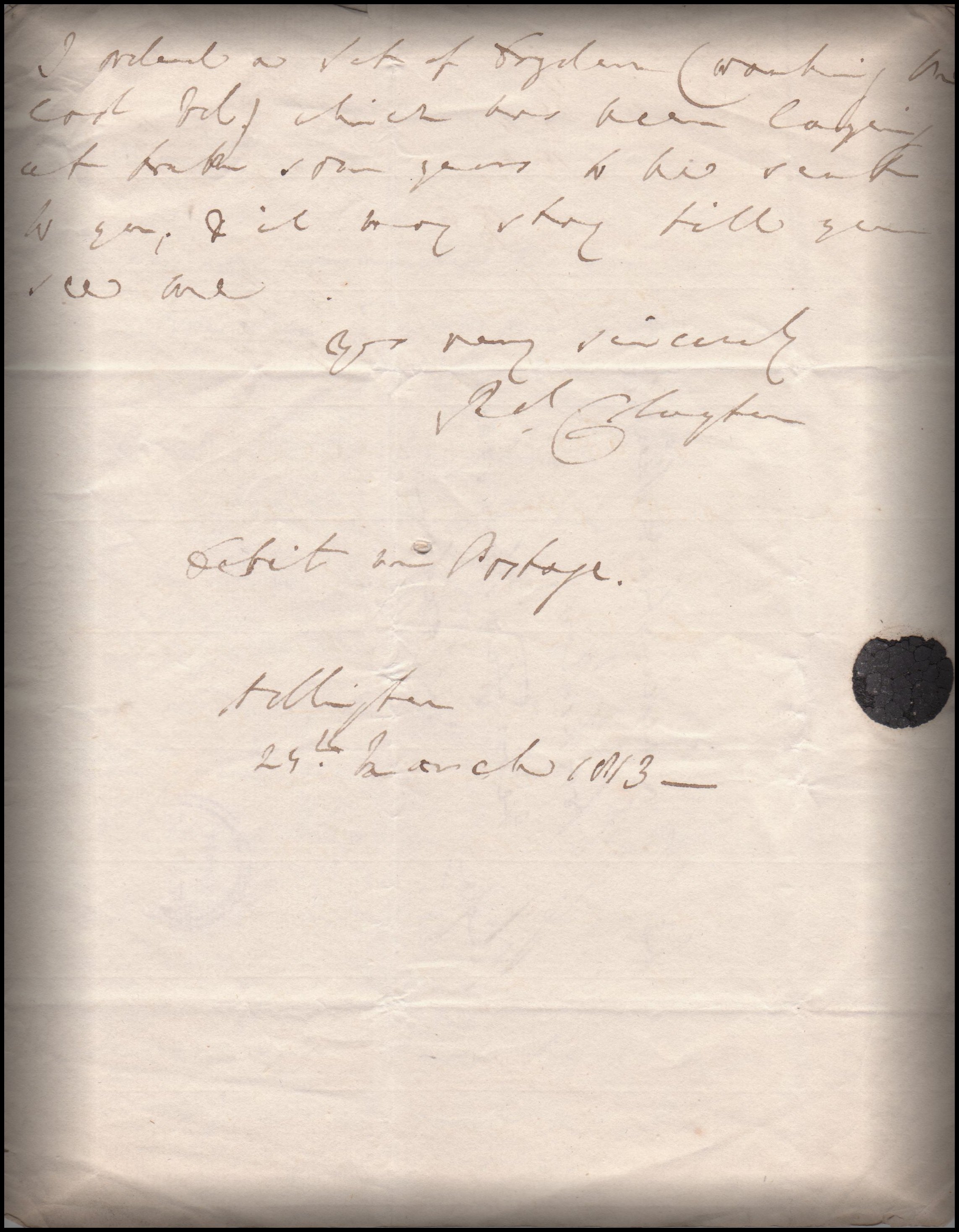
"I am in immediate want of | Arriani Tactica. Blancardi | 8[v]o. Amst[erdam]. 1683. and I shall be much obliged to you if you will get it me & send it down by the Manchester Coach ((not by mail [underlined]) for me soon . directed for me at Adlington near Chorley - to be left at the Elephant in Adlington - You will be particular in the edition of 1683 [underlined] (which is neither a scarce nor a dear book but quite common) as I want a Passage out of it for a little work which I have in Hand - I shall be in Town . & I shall then consult you on the Printing of it .- There is a copy of this edition of Arrian [?] No. 687 in Mackinlays Catalogue (No. 87 Strand) published after his death & very likely you will get it off Turner who succeeded him. It is marked 12- [12 shillings] If the other books I ordered are finished they may come down together by the Waggon & in that case you will direct them as formerly for me at Adlington to the Care of Mr [?] Cabinet Maker Market Street Lane Manchester. I ordered a set of Dryden (wanting the last vol.) which has been laying at [?] some years to be sent to you, & it may stay till you see me." The white space has figures presumably made at the Temple of Musesand applicable to Clayton's purchases.
Note: This Richard Clayton published a"Treatise on Greyhounds" (1816, COPAC records, London : Printed by A.J. Valpy for Messrs. Lackington, 1816).
Bibliographic Details
Title: Autograph Letter Signed "Rd. Clayton"
Publisher: Lackington
Publication Date: 1813
Signed: Signed by Author
Sir Richard Clayton - 1813 "directed for me at Adlington near Chorley - to be left at the Elephant in Adlington".
The Elephant at Adlington 2012.

Sir Richard Clayton published a "Treatise on Greyhounds" ( COPAC records for 1816).

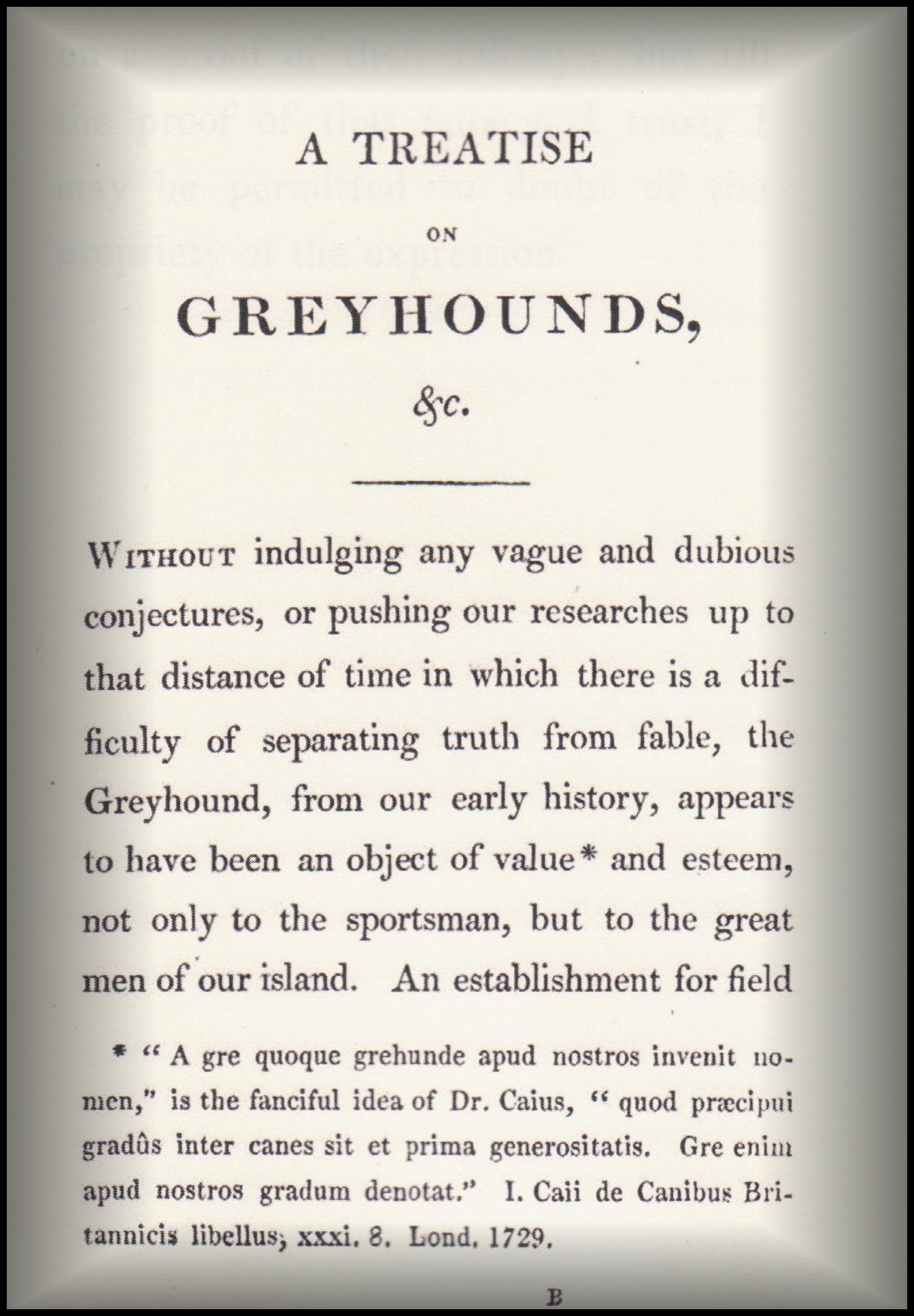
Clayton, of Adlington, Lancashire.
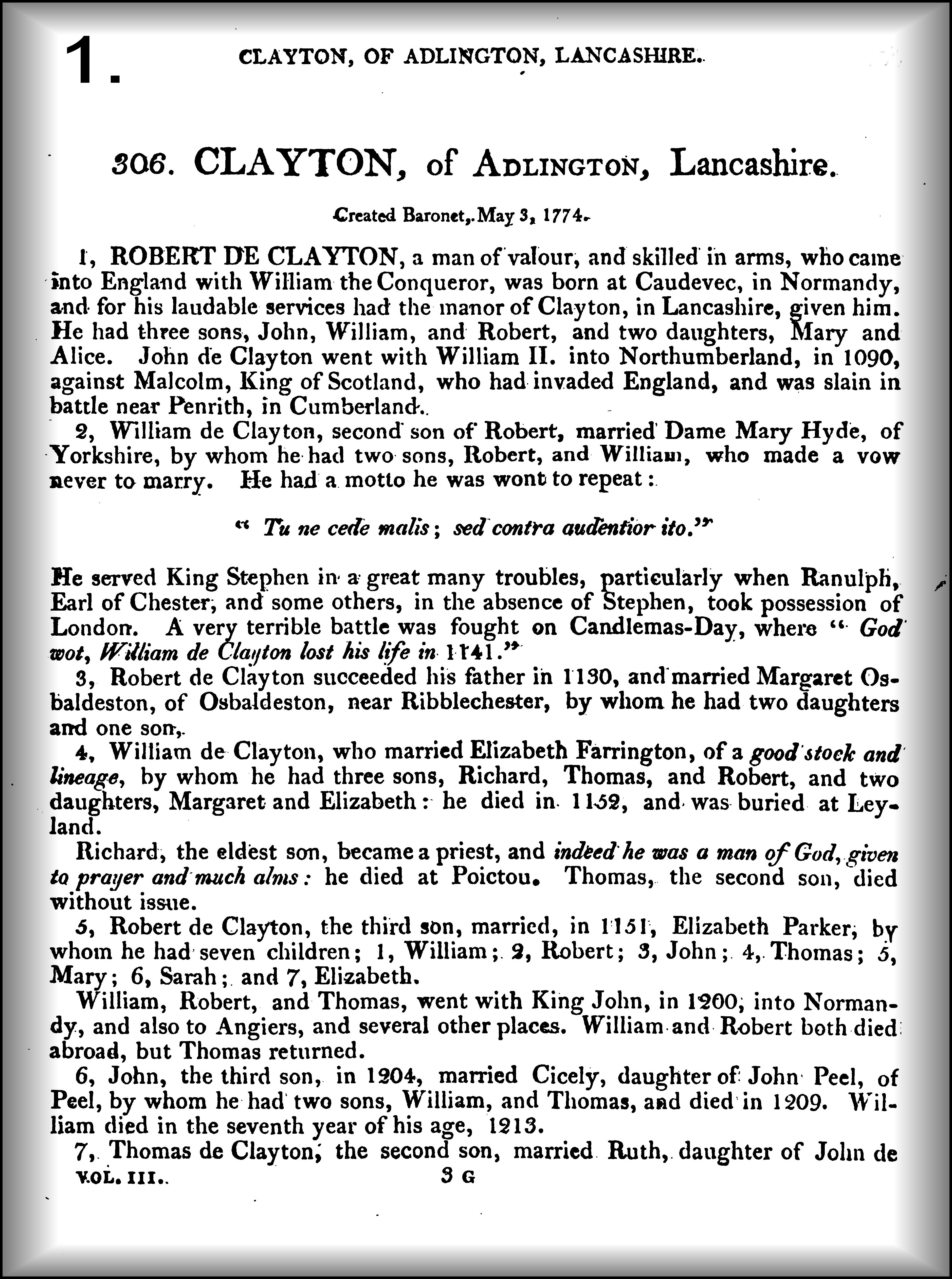
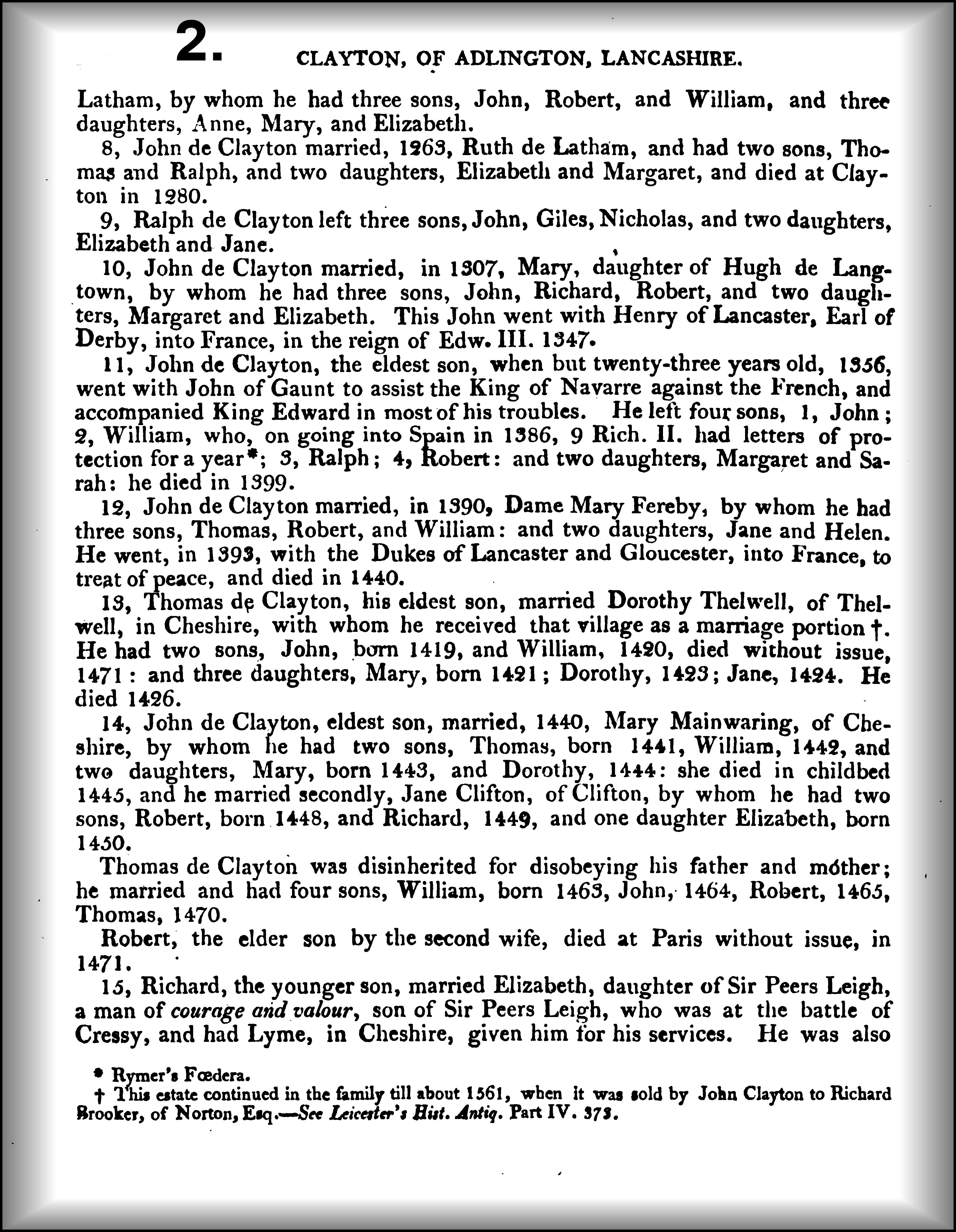

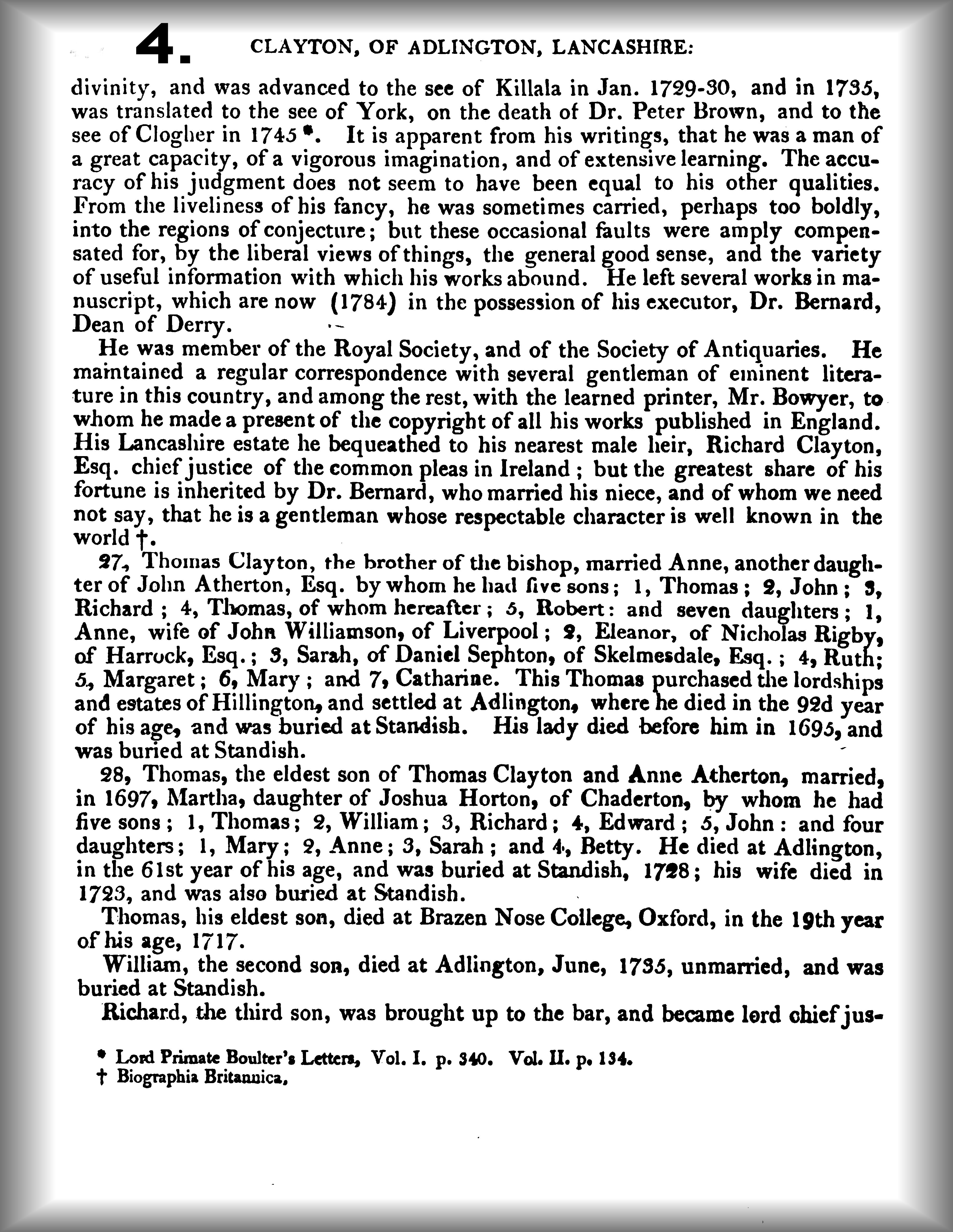


![]()
People and events in Adlington 1305 to 1881 (a small selection of many).


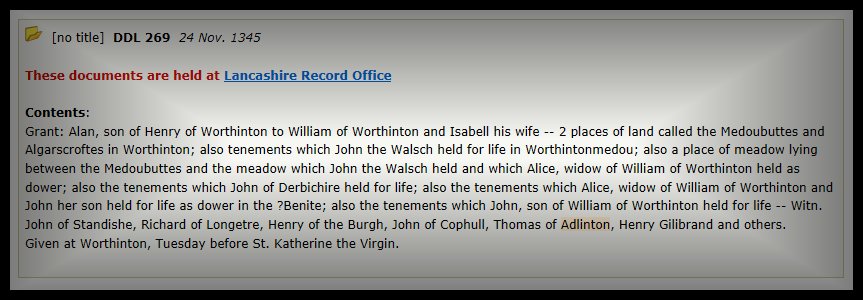


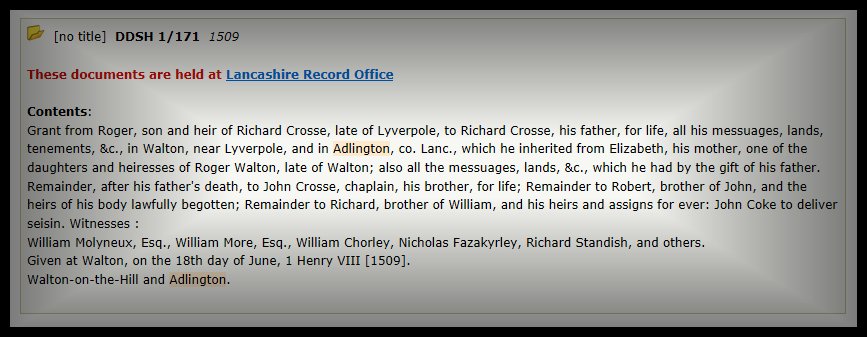



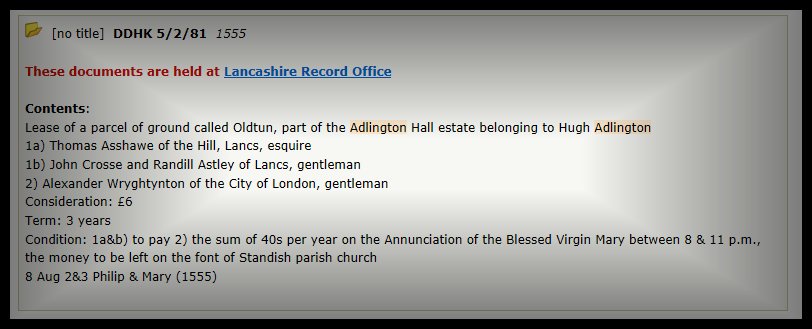


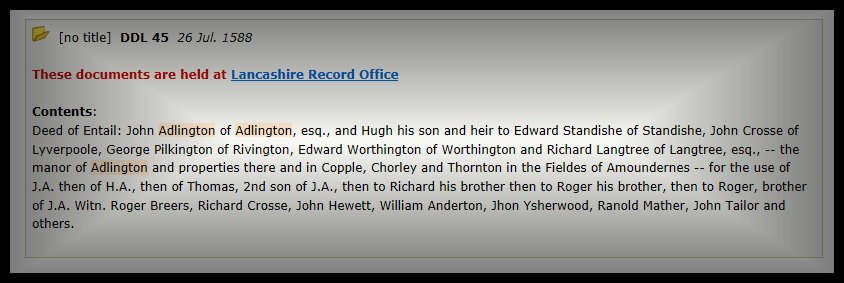
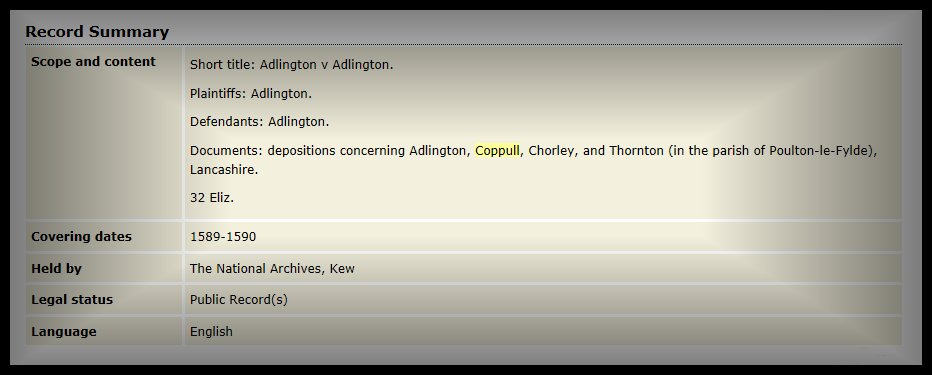
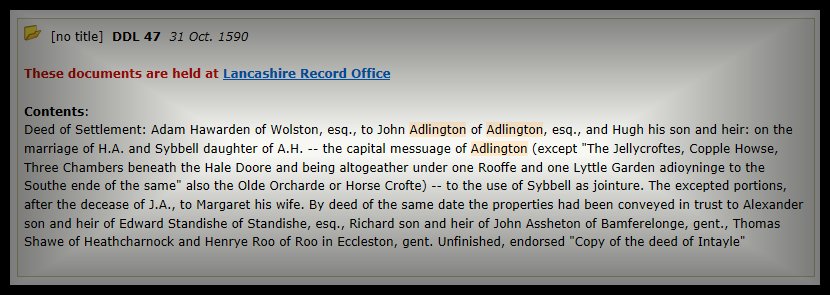








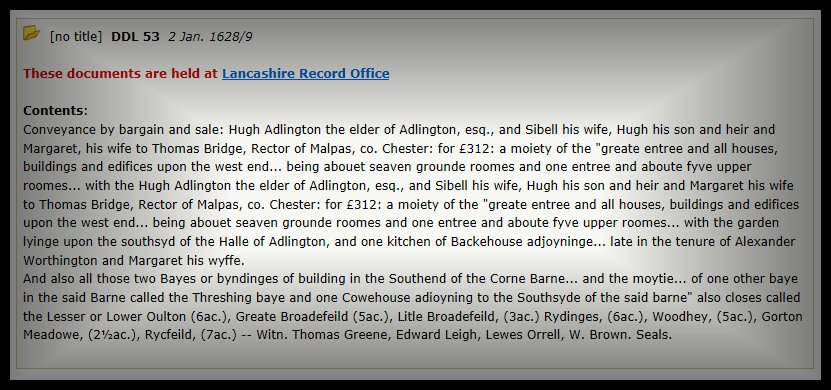
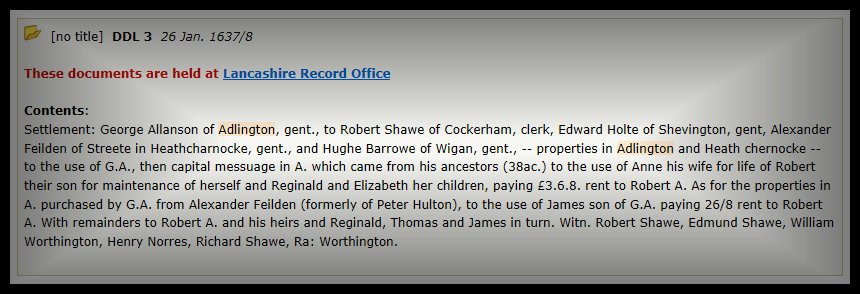






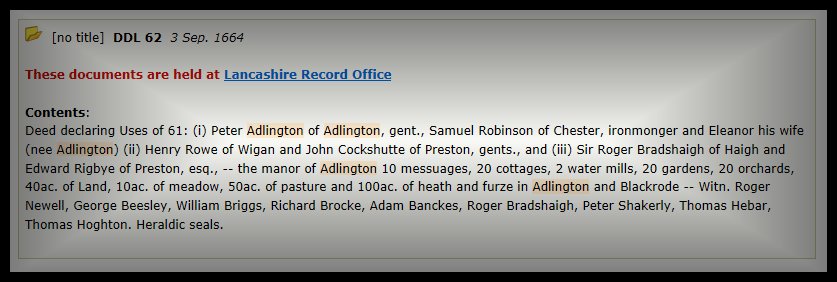






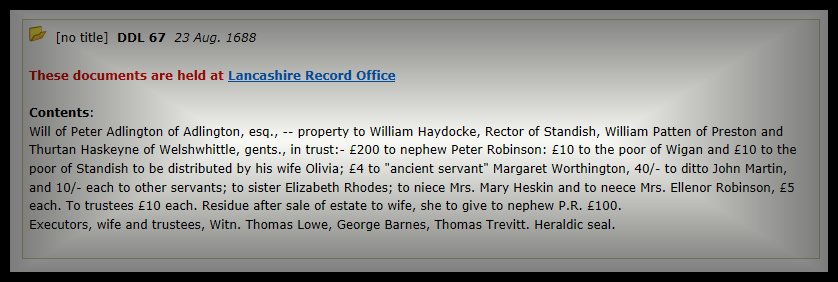











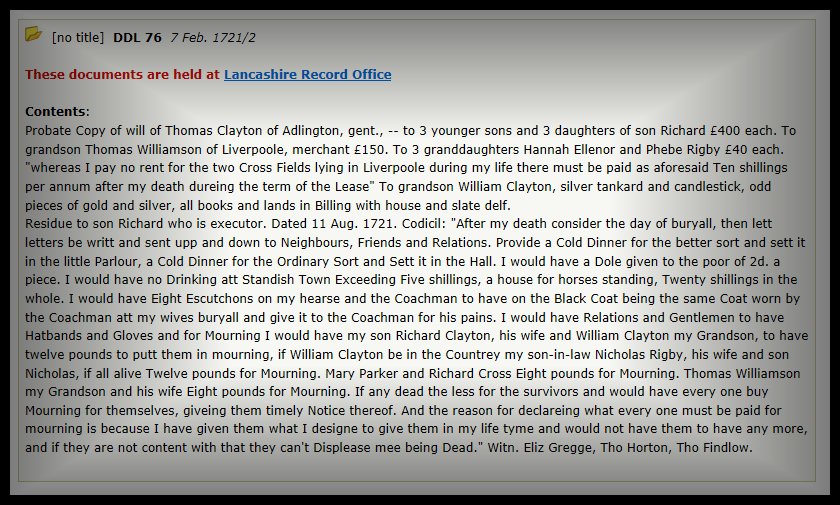






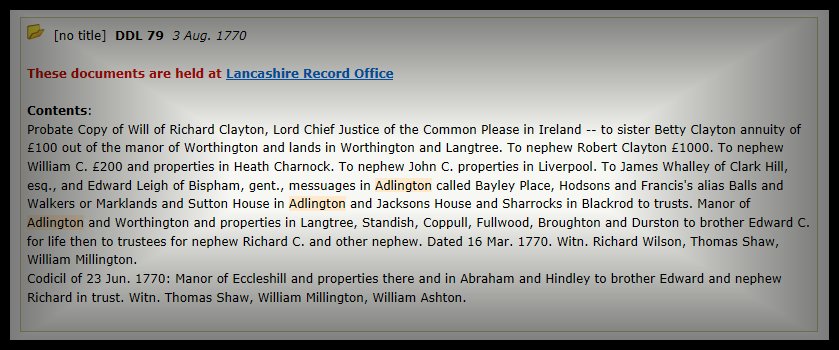

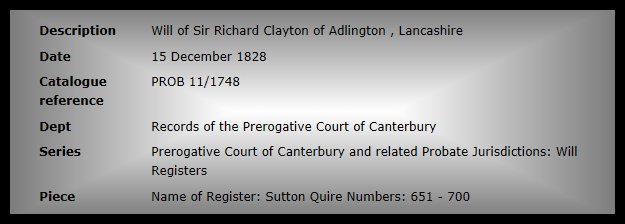

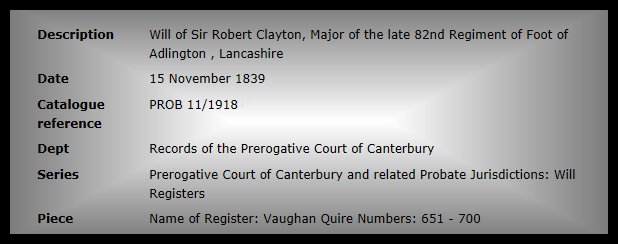


Year 1705 - 1825 Bastardy.







Year 1778 - 1831. "the Order of the Boot" kicked out of Adlington!





1826 - 1837 Returned to Adlington.



![]()
Other holders of Lands upon the Manor of Adlington.
The Duxbury moiety of the manor appears to have been sold or otherwise alienated early in the 14th century, becoming much subdivided. A branch of the Duxbury family continued to hold lands in Adlington as in Duxbury itself. Thus Ughtred Duxbury in 1513–14 made a feoffment of his lands, including some in Adlington; Standish D. (Local Glean. ii), no. 220. Thomas Duxbury had the same in 1525; Pal. of Lanc. Feet of F. bdle. 11, m. 177. These were probably the lands in Adlington held by Edward Standish of Standish in 1610; the superior lord was Hugh Adlington, and a rent of 6d. was payable; Lancs. Inq. p.m. (Rec. Soc. Lancs. and Ches.), i, 191.
Various suits introduce holders of land in the township.
In 1292 Thomas Wen was non-suited in a claim against William de Worthington and
Mabel his wife; Assize R. 408, m. 58.
John son of Thomas Wen in 1305 claimed 7 acres in Adlington against Henry son of Thomas Wen, Henry Nightegale and others, Henry in the result being sent to gaol for denying his own charter; ibid. 420, m. 7.
John Wen in 1346 demised for life to Adam de Perburn land from the waste in 'Foghmore' which he held by grant of Thomas son of Henry Wen; Kuerden MSS. iii, A 2, no. 3, 5
Henry son of Robert de Walhull also succeeded in his claim against Henry Wen; ibid. Thomas Wen, on the other hand, sought messuages and land in Adlington in 1343 against Alice daughter of Henry de Walhull and others; De Banco R. 337, m. 93 d.
Roger Asshaw's messuages and land in Adlington in 1540 were held of the heir of William de Ferrers by a rent of 8¼d. yearly Duchy of Lanc. Inq. p.m. viii, no. 11.
Reginald Allanson, who died in 1598 holding a messuage, in
Adlington, is recorded in Heath Charnock. The residence, however, seems to have
been in Adlington, at a place called Rigshaw.
George Allanson, who was the son and heir of Reginald, in 1627 made a small grant of land near Allanson House to Hugh Adlington; Kuerden MSS. iii, A 2, no. 18.
Roger Anderton in 1593 purchased from James Aughton and Alexander
Sharples alias Ward and Anne his wife the 'manor' of Adlington and
various lands; Pal. of Lanc. Feet of F. bdle. 55, m. 197. From the pedigree
above referred to it appears that Anne was one of the daughters and co-heirs of
John Aughton.
The purchaser was no doubt the son of Christopher Anderton of Lostock who had
himself made various purchases in Adlington and Heath Charnock; see Lancs.
Inq. p.m. (Rec. Soc. Lancs. and Ches.), ii, 27. As Roger Anderton of
Birchley, near Wigan, the son held some land in 1640, but the tenure is not
stated; Duchy of Lanc. Inq. p.m. xxx, no. 7. Roger Anderton, a convicted
recusant, paid to the subsidy in 1628; Misc. (Rec. Soc. Lancs. and
Ches.), i, 167.
In 1654 Robert Holt purchased the 'manor' of Adlington with lands, &c., in
Adlington, Anderton and Blackrod, from James Anderton (of Birchley), Anne his
wife, Roger Anderton, William Anderton (of Anderton), Magdalen his wife,
William Anderton, Thomas Gillibrand, Anne his wife, John Gillibrand and
Elizabeth his wife; Pal. of Lanc. Feet of F. bdle. 153, m. 195.
|
Roger Crosse in 1522 held messuages and land in Adlington of the lords of Leylandshire by a rent of 8½d.; Duchy of Lanc. Inq. p.m. vi, no. 18. |
|
Lawrence Breres, the heir of Crosse, held land in Adlington in 1584 of the Earl of Derby and Sir Richard Shireburne by the above rent of 8½d.; ibid. xiv, no. 8. See ibid. xvii, no. 34, and Lancs. Inq. p.m. (Rec. Soc. Lancs. and Ches.), i, 233. The houses, &c., were sold to Roger Fazakerley of Walton; Cal. Com. for Comp. iv, 2521. |
John Pilkington, who had at first adhered to the king, but, becoming convinced of his error, had then borne arms for the Parliament in the Civil War, yet found his estate sequestered, and begged leave to compound in 1651. (fn. 37)
|
The Lancelyn family held lands, in Adlington, Charnock Gogard and Duxbury of the heir of Lord de Ferrers; Duchy of Lanc. Inq. p.m. vi, no. 23; ix, no. 1. 'Lancelyn's meadow' was in the time of Edward VI in the possession of Lawrence Asshaw (Ducatus Lanc. i, 262), so that he may have purchased the Lancelyn estate in the neighbourhood.
|
|
The descent of this family is unknown. It is possible that they were related to William de Worthington and Mabel his wife whose possessions about 1300 have been named in preceding notes. Thomas de Worthington and Nicholas his brother occur in 1369; Kuerden MSS. iii, W 27. The former seems to have been of Blainscough, the latter may have been of Crawshaw. Nicholas de Worthington and Joan his wife have
occurred in 1443. A writ of diem claus. extr. after the death of Lawrence
Worthington in 1446 may refer to one of this family; Lancs. Rec. Inq. p.m.
no. 32. Pedigrees were recorded in 1613 (Visit. Chet. Soc. p. 126) and 1665 (Dugdale'sVisit. p. 342). The former begins with a Christopher Worthington, probably living in the time of Edward IV. Christopher was no doubt the husband (1450) of Joan, another of the daughters and heirs of William Thornton already named;Final Conc. iii, 117. Joan died in 1501 holding part of Thornton and leaving a son and heir Lawrence, aged thirty; Duchy of Lanc. Inq. p.m. iii, no. 108.
Crawshaw Adlington 2012.
|
![]()
In the year 1613: A monstrous birth in Adlington.
A monstrous birth in 1613 was the subject of a pamphlet by Mr.Leigh, the rector of Standish.
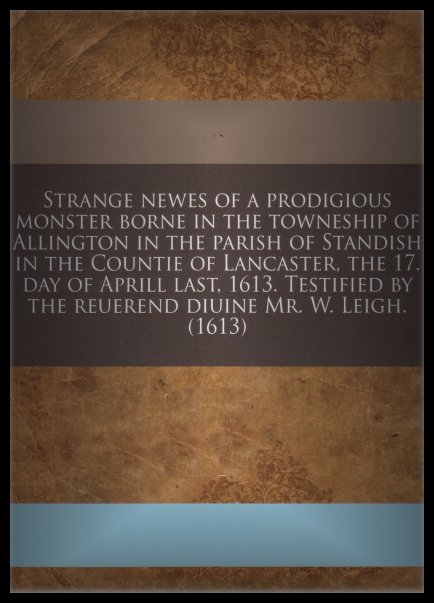
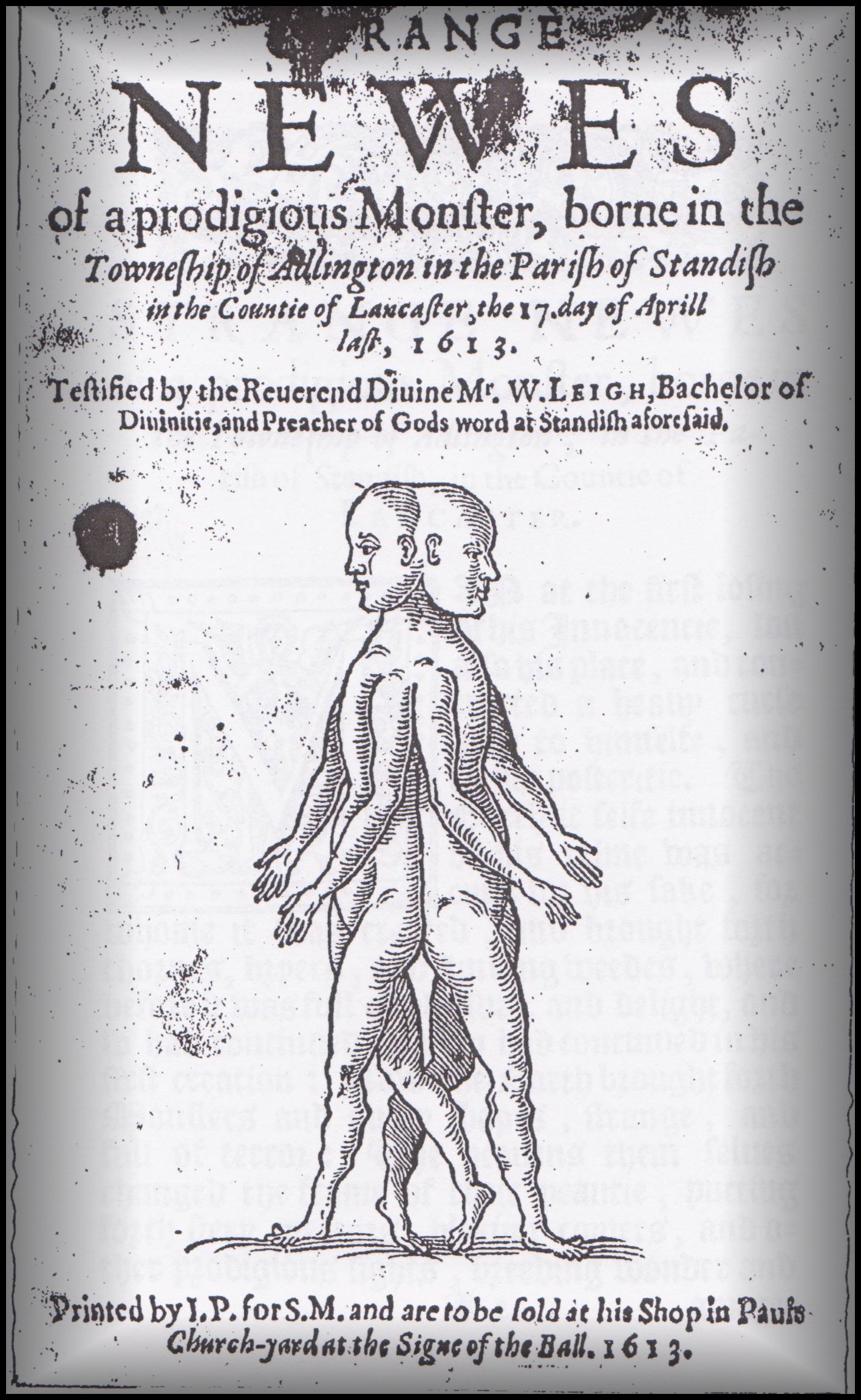

![]()
St. Paul's Church Adlinton.
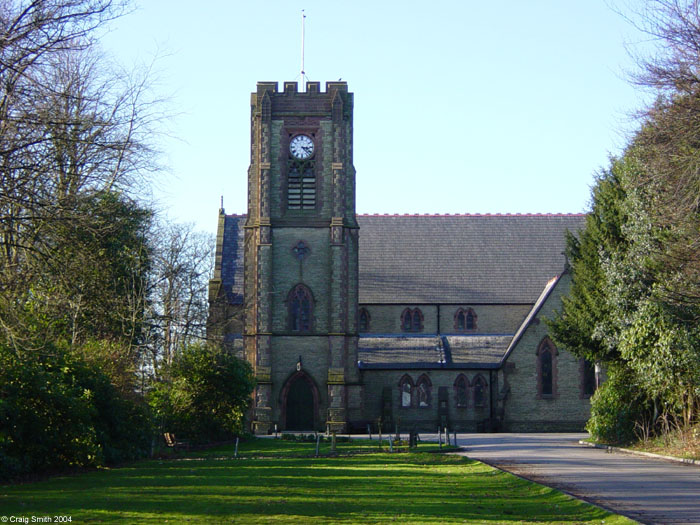
In connexion with the Church of England Christ Church was built in 1839; and was used as a chapel of ease to St. Paul's, erected in 1884.
Christ Church - Adlington.
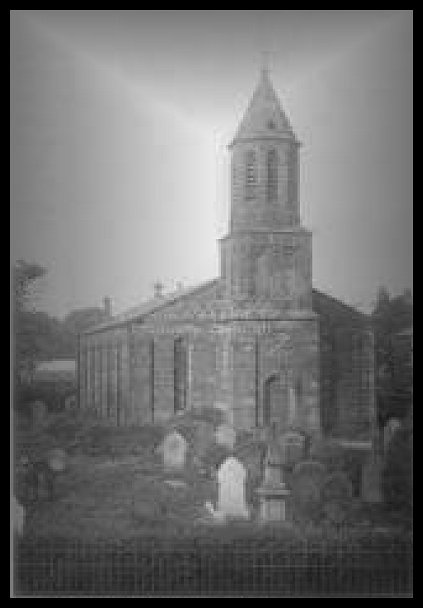
![]()
A grammar of the dialect of Adlington, by John Hargreaves, published at Heidelberg in 1904.
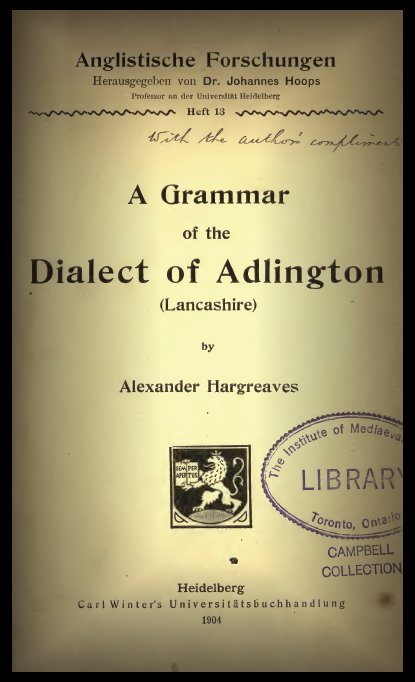
A grammar of the dialect of Adlington. DOWNLOAD pdf file.
![]()
Old Adlington.


Adlington 2012.
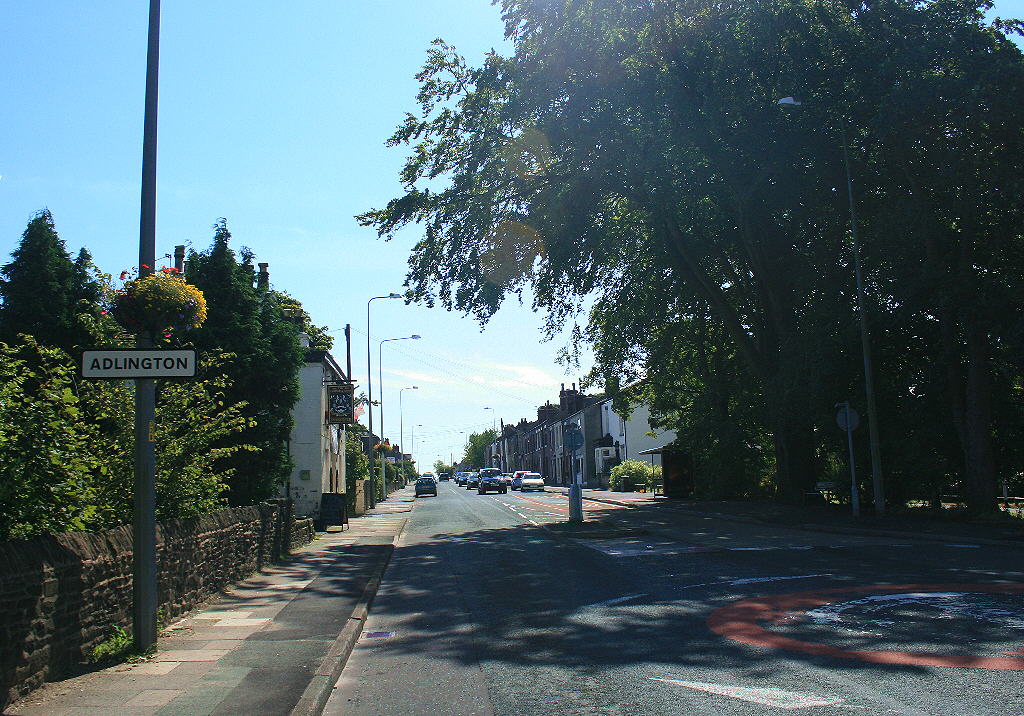
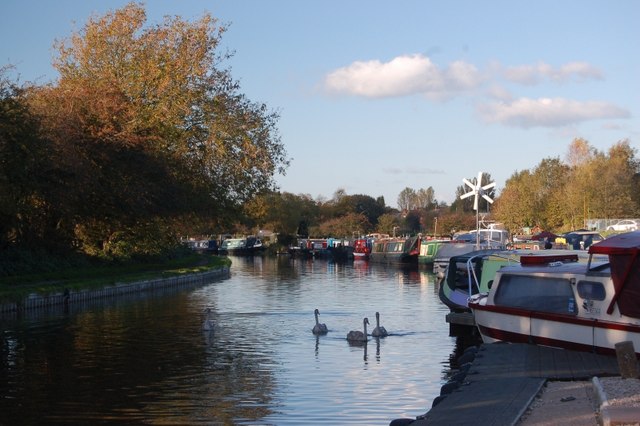
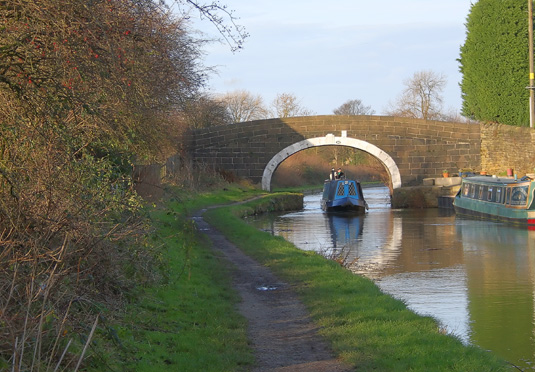

![]()